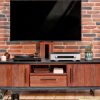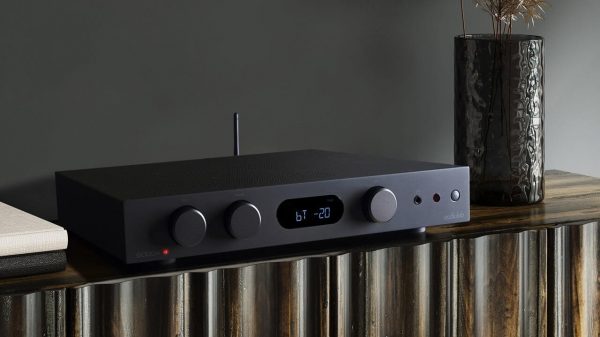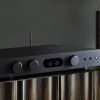As a budding audiophile, I’ve often wondered what would be the best component to upgrade in my system; Turntable? Amplifier? Speakers? While any changes made have the potential to improve a system, I think that some of the best bang for your buck can come from changes to your amplifier and preamplifier. What has convinced me? Testing out Cambridge Audio’s Alva Duo Phono Preamp and the Cambridge Audio CXA61 Integrated Amplifier.
Listening to records is my primary format so investing in a better-quality integrated amplifier with a high-quality MM phono stage, or external phono preamp has been on my upgrade list for the past few years.
There are so many which is great for people getting into vinyl for the first time, but that doesn’t mean that you can randomly select one and expect to achieve great results.
As I’ve discovered from my own listening experiences and from conversations with my colleagues here, there can be huge differences in sound quality between $250 and $1,000 and it’s more about cartridge/preamp compatibility than just how a unit sounds.
We have some excellent options in that price range which you can find here.
Most phono preamps are designed for either MM alone, or MM/MC cartridges, and I had never given that much consideration to the differences between them and how a well engineered phono preamp can extract a lot more musical information from entry-level cartridges.
I’ve had the chance to listen to a few expensive phono cartridges and I lean towards using those between $250-$400 with a better-quality phono preamp to be quite honest. Like most people, I would rather spend the money on more records.

The Cambridge Audio Alva Duo raised the bar for me, and I suspect that a lot of people with a similar system below $2,500 would find it quite appealing.
Retailing for $349 USD, the Alva Duo really packs a punch in terms of its features and sound quality; It supports both moving magnet and moving coil cartridges, with separate inputs for each. It also sports a 6.35mm headphone jack.
Cambridge Audio did not add this as some cheap throw-in; the dedicated headphone amplifier has ample power for a lot of headphones (perhaps not higher impedance planar magnetic ones) and sounds quite good.
The rear panel also includes a balance control dial (something I’ve not seen on a phono preamp before), and I loved that Cambridge Audio labels everything with the print upside down as well so that you can see where you are inserting your interconnects from above if operating in tight corners on a rack. A single grounding post exists in-between both sets of inputs.
The MM section offers 39.5 dB of gain, and MC cartridge users have 60 dB of gain as well; there is no way to adjust the loading or impedance for MC carts which is set to 100 Ohms.
MM cartridges from Ortofon, Grado, Nagaoka, and Audio-Technica with 3.5mV or higher will be good choices for the Alva Duo.

Sound
As soon as I added the Alva Duo to my existing system – Denon DP-300F turntable Pro-Ject turntable with Ortofon 2M Silver MM cartridge, Insignia NS-R2001 receiver, and Bowers & Wilkins 686 speakers – the difference in sound quality was undeniable. Two things stood out the most – the bass response and level of detail. The low end of my system has never been particularly strong or clear, but the Alva Duo changed that in an instant. I could suddenly feel the bass but also hear it more distinctly too. Bass notes had a lot more definition and greater speed.
Listening to a range of music from Neil Young to Radiohead to Muddy Waters, the soundstage opened up substantially. It felt like peeling back the layers of an onion — I could hear so many more layers of music for the first time; like little bits of percussion and ambient flourishes that previously were not there.

Overall, I felt the Alva Duo provided a more balanced sound, adding a good deal of warmth to my system. I listen to a lot of acoustic music and like to hear the definition in those instruments and voices that are often brighter. The Alva Duo gives me that level of detail retrieval without sacrificing any midrange resolution or low-end punch.
Adding the compact Alva Duo to your system is one of the easiest ways to upgrade at an affordable price. I highly recommend it to anyone looking to make a first upgrade to their system. If you’re ready to take things up a notch further, adding an integrated amplifier to your setup can do just that.
Enter the Cambridge CXA61

Interestingly, the CXA61 is an integrated amp without a phono stage; a phono preamp like the Alva Duo is necessary to connect a turntable. For anyone who primarily listens to vinyl (myself included), it is a slight drawback to require a separate phono stage, though it can be argued that this integrated amplifier will likely be used with better quality loudspeakers and turntable and the likely purchaser will already be considering a better-quality external phono preamp.
The less expensive Cambridge Audio AXA35 that we already reviewed does come with its own MM phono preamp for less than $450; the CXA61 has a lot more power and a myriad of digital inputs that are not part of the less expensive model.
Set-up of the CXA61 was a breeze. All I needed to grab was a standard RCA cable. After a bit of time acquainting myself with the inputs, I was ready to go. The only thing I wish would have been included was the full user manual, though a quick Google search brought me a digital copy in no time.
I’ve been thoroughly impressed with the flexibility the CXA61 provides through its connections and features. From an analog perspective, there are 4 stereo RCA inputs and a 3.5mm DAP player input on the front panel.
On the digital side, there is a direct USB input along with coaxial and two optical digital inputs. Bluetooth aptX HD is also built-in, giving the ability to stream music wirelessly at the highest possible quality; which is still lossy for those who just signed up for Apple Music with lossless and lossless hi-res music. The internal DAC supports different bit/sample rates depending on the digital input used.

USB supports up to 32-bit/384kHz PCM and DSD256 files. The Optical Toslink input (Roku Box, older legacy CD players) supports up to 32-bit/96kHz PCM.
I was expecting (and hoping for) a lot of power, and the Cambridge amplifier did not disappoint. The Cambridge Audio CXA61 delivers 60 watts/channel into 8 ohms and was designed to play with very low levels of distortion at any volume.
I found this to be overwhelmingly true as I experimented with all types of music at many volume levels. The amp is incredibly responsive, sounding equally fantastic at low and high volumes. Some high-end equipment sounds rather “mid-fi” at lower volume levels but I found the CXA61 to be quite engaging in this manner.

One omission on the CXA61 is tone controls. As someone who has only ever known amplifiers with tone controls, I was somewhat frustrated that Cambridge Audio CXA61 did not include them. The more I listened to the amplifier, the greater my appreciation for its tonal balance and I started to understand the voicing and presentation of the amplifier and why they were ultimately not necessary.
The addition of the CXA61 only served to enhance the imaging and enlarged soundstage that I heard from the Alva Duo. Listening to Ray Charles’ Genius + Soul = Jazz, the music felt so alive. The dynamics were captured so accurately, and I could feel the swell of the big band as though it were playing right in front of me.
There is again no sacrificing on the low end or detail here; the bass response is commanding with a rich tonal balance that worked exceptionally well with my Bowers & Wilkins speakers. It was a lot of fun to hear my long-term speakers sound that much larger and engaging with the Cambridge Audio CXA61; I found myself listening to some albums in a very different way as I realized just how much musical information I was missing with my previous amplifier.
$999 (now $599) is not an inexpensive upgrade for most people but the Cambridge Audio CXA61 is certainly a great entry-point into high-end integrated amplifiers. It’s built to a very high standard, easy to use, and it can be used as the hub of an excellent sounding stereo that would be a huge step up for most people.
In the context of most high-end systems available in 2022, the Cambridge Audio CXA61 is a great value as well. It’s not without some fierce competition from Rega, Naim, Arcam, Rogue Audio and Croft – but it’s something that I could live with very easily.
Highly recommended.
Where to buy:
- Cambridge Audio CXA61 – $599 at Amazon
- Cambridge Audio Alva Duo – $349 at Amazon



































Mike Cornell
July 6, 2021 at 1:24 pm
While I can appreciate the tonal balance of an amp unfettered by tone controls on a perfectly mastered recording, we all know many recordings are far from perfect and can be made more listenable by some judicious tweaking of properly implemented tone controls. As long as they are switchable out of the circuit, that’s why they are a ‘must’ for me, and this amp, despite its virtues, is a no-go.
Jay
December 10, 2021 at 6:41 am
As much as this phono preamp is a great performer noise and distortion wise, especially seen its price, its headphone amp is in fact a cheap throw-in. Check out this article: https://www.audiosciencereview.com/forum/index.php?threads/review-and-measurements-of-cambridge-audio-duo-phono-preamp.6901/
Ian White
December 10, 2021 at 11:25 am
Jay,
It’s a phono stage. A very good one for the money. ASR’s data is fine but I trust my ears more than their measurements.
Ian White
Steven Denfeld
December 10, 2021 at 9:09 pm
I once read through like 17 pages on the ASR forum regarding a boutique brand’s well-liked phono amp where three separate measurement gurus posted their findings and absolutely crapped all over this unit, even after strong and continued input from the designer himself defending his design choices. And you know what? None of those ‘experts’ even bothered to actually plug the device into their system and listen to it with their ears. Not a single one of them could be bothered. That caused me to lose a lot of respect for that particular community. I’ll let my ears tell me if a phono amp sounds good, not some weird culty dude’s machine, thank you. No disrespect intended to you, of course—measurements have their place, I guess, but not when it becomes a religion.
Ian White
December 10, 2021 at 9:15 pm
Steven,
I’ve spent a lot of time with the CA gear (I own 4 pieces) including this phono preamp. I’ve tried it with 6 MM cartridges. I rather like it.
I find the ASR community odd. I appreciate the value of measurements but not when it trumps how an actual component truly sounds.
Ian White
Rob
December 26, 2021 at 10:42 pm
I have been using both these components for 6 months now and I have to agree with every comment in the article. I actually upgraded (?) from the Cambridge CXA 80 amp just to get the improvements in the CXA 61. I didn’t miss the drop in power as I never really went to super high volumes. I upgraded from a ‘cheap’ project phono amp.
Ealu
January 1, 2022 at 7:10 pm
A wonderful, down to earth review. Thank you. I am a beginner audiophile and can quickly get overwhelmed and discouraged by the complexity and enormous costs involved in the “must haves”. Like you, I would rather spend my money on the actual music. After all, that’s what it’s about. I am actually building my first speakers to keep the cost down. These speakers will be neutral in nature and I was considering one of the Cambridge integrated amplifiers. Your review has helped me decide. I don’t want components and wires all over the place, preferring to keep things simple and clean. I live in a house with my family and the living room is a shared space. The quality of the music will be excellent and will make me happy. Thanks again. Enjoy the music.
Jay sucher
January 15, 2022 at 9:46 pm
I bought the Cambridge Alva duo a few years ago to use with my modest mid grade Onkyo, Rega RP1 w Grado Prestige cartridge and Vintage Klipsch heresy speakers. While not high end at all, it works great for me.
Ian White
January 15, 2022 at 9:57 pm
Jay,
Which is the only thing that matters.
How it sounds to you.
Nice system BTW.
Ian White
ORT
August 19, 2022 at 3:39 pm
“Like most people, I would rather spend the money on more records.” Lauren
“Lauren, I think this is the beginning of a beautiful friendship. Here’s reading you, kid.” – ORT. By way of Rick Blaine in Casablanca.
ORT
Ian White
August 19, 2022 at 5:22 pm
ORT,
She’s a fantastic wealth of knowledge when it comes to music and a massive baseball fan.
Best,
Ian White
ORT
August 21, 2022 at 9:57 pm
Ian, two of my brothers are baseball fans. Since the first strike about 5 decades ago, I am not (I can really hold a grudge, don’tcha know). I have been to the Baseball Hall of Fame and whilst the historical importance was respected by my self, the hysterical aspect of the game were ignored.
But as far as music and turntables are concerned, I look forward to her words here!
If she mentions baseball, I shall mention her work to my brothers! Just because I do not care (okay…More “I LOATHE all sports”) does not mean the game of baseball should not be considered worthy of the title of our national pastime.
ORT
Nick
September 25, 2023 at 11:59 pm
Great review! Recently picked up both the cxa61 and duo. Pretty new to this is there a best input to have the phono connected to?
Ian White
September 26, 2023 at 10:17 am
Nick,
Welcome. AUX (if there is one) would make the most sense. Definitely not TAPE.
Enjoy.
Best,
Ian White
Shom
February 11, 2024 at 1:28 pm
In terms of pairing the Cambridge Audio CXA61 with the Q Acoustics, which would be paired better? The 3050i or the 5040?
Thanks.
Ian White
February 11, 2024 at 2:49 pm
Shom,
5040. The tonal balance being the primary reason. Two really good speakers, but the treble of the 3050i is far more restrained and needs something more analytical sounding than the CXA61.
Best,
Ian White